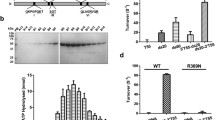Summary
We report the isolation and biological properties of two T4 phage mutants which are deficient in polynucleotide kinase. These two mutants are wild type with respect to replication, genetic recombination and DNA repair (as measured by sensitivity to UV irradiation, γ-irradiation and 32P decay). These negative results suggest that this phage-induced enzyme is not a critical factor in DNA metabolism.
Similar content being viewed by others
References
Adams, M.: Bacteriophage. New York: Wiley (Interscience) 1959.
Boyle, J. M., Symonds, N.: Radiation-sensitive mutant of T4D I. T4y: A new radiation-sensitive mutant; effect of the mutation on radiation survival, growth and recombination. Mutation Res. 8, 431–439 (1969).
Chase, M., Dörmann, A. H.: High negative interference over short segments of the genetic structure of bacteriophage T4. Genetics 43, 332–353 (1958).
Ebisuzaki, K.: Functional Interdependence of genes in bacteriophage T2. J. molec. Biol. 5, 506–510 (1962).
Fraser, D., Jerrel, E. A.: The amino acid composition of T3 bacteriophage. J. biol. Chem. 205, 291–295 (1953).
Freidberg, E. C., King, J. J.: Endonucleolytic cleavage of uv-irradiated DNA controlled by the v+ gene in phage T4. Biochem. biophys. Res. Commun. 37 646–651 (1969).
Freifelder, D.: Mechanism of inactivation of coliphage T7 by x-rays. Proc. nat. Acad. Sci. (Wash.) 54, 128–134 (1965).
— Lethal changes in bacteriophage DNA produced by x-rays. Radiat. Res., Suppl. 6, 80–96 (1966).
Harm, W.: Gene controlled reactivation of ultraviolet inactivated phage. J. cell. comp. Physiol. 58, 69–77 (1961).
— Mutants of phage T4 with increased sensitivity to ultraviolet. Virology 19, 66–71 (1963).
Hershey, A. D., Kamen, M. D., Kennedy, J. W., Gest, H.: The mortality of bacteriophage containing assimilated radioactive phosphorus. J. gen. Physiol. 34, 305–319 (1951).
Kaplan, H. S.: DNA-strand scission and loss of viability after x irradiation of normal and sensitized bacterial cells. Proc. nat. Acad. Sci. (Wash.) 55, 1442–1446 (1966).
McGrath, R. A., Williams, R. W.: Reconstruction in vivo of irradiated Escherichia coli deoxyribonucleic acid; the rejoining of broken pieces. Nature (Lond.) 212, 534–535 (1966).
Novogrodsky, A., Hurwitz, J.: The enzymatic phosphorylation of ribonucleic acid and deoxyribonucleic acid. I. Phosphorylation at 5′-hydroxyl termini. J. biol. Chem. 241, 2923–2932 (1966).
—, Tal, M., Traub, A., Hurwitz, J.: The enzymatic phosphorylation of ribonucleic acid and deoxyribonucleic acid. II. Further properties of the 5′-hydroxyl polynucleotide. J. biol. Chem. 241, 2933–2943 (1966).
Ogawa, H., Tomizawa, J.: Breakage of polynucleotide strands by disintegration of radiophosphorous atoms in DNA molecules and their repair. I. Single-strand breakage by transmutation. J. molec. Biol. 30, 1–6 (1967).
Richardson, C. C.: Phosphorylation of nucleic acid by an enzyme from T4 bacteriophage infected Escherichia coli. Proc. nat. Acad. Sci. (Wash.) 54, 158–165 (1965).
— Enzymes in DNA metabolism. Ann. Rev. Biochem. 38, 795–840 (1969).
Setlow, R. B., Carrier, W. L.: The v-gene controls dimer excision in T4 phage. Biophys. J. 6, 102 (1966).
Stent, G. S., Fuerst, C. R.: Inactivation of bacteriophage by decay of incorporated radioactive phosphorous. J. gen. Physiol. 38, 441–458 (1955).
Takagi, Y., Sekiguchi, M., Okubo, S., Nakayama, H., Shimada, K., Yasuda, S., Mishimoto, T., Yoshihara, H.: Nucleases specific for ultraviolet light-irradiated DNA and their possible role in dark repair. Cold Spr. Harb. Sym. quant. Biol. 33, 219–227 (1968).
Tomizawa, J., Ogawa, H.: Breakage of polynucleotide strands by disintegration of radiophosphorous atoms in DNA molecules and their repair. II. Simultaneous breakage of both strands. J. molec. Biol. 30, 7–15 (1967).
— Breakage of DNA in rec + and rec - bacteria by disintegration of radiophosphorous atoms in DNA and possible cause of pleiotropic effects of rec A mutation. Cold Spr. Harb. Symp. quant. Biol. 33, 243–251 (1968).
Author information
Authors and Affiliations
Additional information
Communicated by Jun-Ichi Tomizawa
Rights and permissions
About this article
Cite this article
Chan, V.L., Ebisuzaki, K. Polynucleotide kinase mutant of bacteriophage T4. Molec. Gen. Genet. 109, 162–168 (1970). https://doi.org/10.1007/BF00269652
Received:
Issue Date:
DOI: https://doi.org/10.1007/BF00269652




